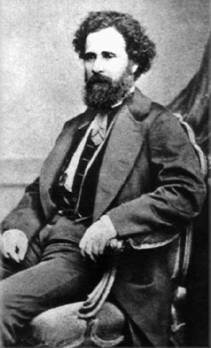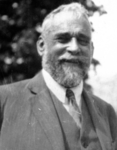National Liberal Party (Romania, 1875)
The National Liberal Party (Romanian: Partidul Național Liberal, PNL) was the first organised political party in Romania, a major force in the country's politics from its foundation in 1875 to World War II. Established in order to represent the interests of the nascent local bourgeoisie, until World War I it contested power with the Conservative Party, supported primarily by wealthy landowners, effectively creating a two-party system in a political system which severely limited the representation of the peasant majority through census suffrage. Unlike its major opponent, the PNL managed to preserve its prominence after the implementation of universal male suffrage, playing an important role in shaping the institutional framework of Greater Romania during the 1920s.
National Liberal Party Partidul Național Liberal | |
|---|---|
 Electoral symbols used by the PNL, with date of introduction | |
| Abbreviation | PNL |
| Founders | Ion C. Brătianu Ion Ghica Mihail Kogălniceanu C.A. Rosetti |
| Founded | 24 May 1875 |
| Dissolved | 1947[lower-alpha 1] 1950[lower-alpha 2] |
| Newspaper | Românul (1875–84) Voinţa naţională (1884–1914) Viitorul (1914–38, 1944–45[lower-alpha 1]) Liberalul (1946–47)[lower-alpha 1] Drapelul (1944–48)[lower-alpha 2] |
| Youth wing | National Liberal Youth |
| Ideology | Liberalism Romanian liberalism Romanian nationalism |
| Political position | Center-right to right-wing |
| Slogan | Prin noi înșine! (Through ourselves alone!) |
History

Though initially opposed to the restoration of deposed King Carol II, it became increasingly supportive of his authoritarian policies, with PNL governments paving the way to a royal dictatorship in the late 1930s. Formally disbanded along all political parties in 1938, party structures were preserved unofficially, with many party members also enlisting in Carol's National Renaissance Front. Tolerated by the totalitarian government of Ion Antonescu, it eventually joined King Michael I and the Communist, National Peasants' and Social Democratic parties in overthrowing the dictator in the closing phase of World War II, enabling the reorganisation of the party in 1944. Part of the first post-war grand coalition governments, it lost its importance as the new Communist-led coalition government used the denazification process in order to remove PNL supporters from government posts. With the Communist-dominated government gaining the upper hand in local politics and starting to crack down on opposition, the party decided to cease political activity in the late 1940s, effectively disbanding itself. After the overthrow of the Communist party rule in 1989, a new party was founded under the same name and assumed the National Liberal legacy.
Dominated throughout its existence by the Brătianu family, the party was periodically affected by strong factionalism. The first major split was led by one of the party founders, C. A. Rosetti, whose followers, supporting rapid and more extensive social reforms, created the Radical Party in the late 1880s. Another major split was caused in 1930 by opposing attitudes towards the restoration of Carol II: Gheorghe I. Brătianu contested Vintilă Brătianu's decision to oppose the King and created parallel organisations, claiming the party's name and legacy. After Vintilă's death, his faction came under the control of Ion Gh. Duca and Gheorghe Tătărescu, realigned with Carol and led several governments, while Gheorghe's continued as a separate party, in opposition to the former's government. The two however reunited shortly before the dissolution of all parties in 1938. The last major split was motivated by the attitude towards the Communist-dominated left-wing alliance in the aftermath of World War II: while Dinu Brătianu, the party's president, opposed the increasing Communist influence, Tătărescu, the general secretary, favoured an alliance with it, hoping to preserve some influence in the Soviet-dominated political context. Both factions claimed the name and legacy of the original party, and, after a period of ambiguity, went on to create parallel organisations. Faced with a severe restriction of its activity by the Communist-dominated government, the first faction dissolved itself in late 1947. The second faction continued to be part of the governing coalitions until November 1947; nevertheless, Tătărescu's opposition to the policy of extensive economic planning pursued by the government led to his replacement as party leader with Petre Bejan. Forced into submission, the faction did not have any political activity after 1950. Deprived of their economic base, members of both factions also suffered political persecution after 1948.
In domestic matters, the National Liberal party supported the development of the local bourgeoisie, seeking to expand the Romanian industry through government subsidies and a protectionist trade policy. Party elites controlled major Romanian-owned enterprises and a significant part the local finance sector, including the National Bank of Romania. At the beginning of the 20th century, PNL, joined by many former leaders of the Romanian Social Democratic Workers' Party, advocated an extension of the electoral franchise and a limited agrarian reform, though this did not prevent a National Liberal government from violently repressing the 1907 Peasants' revolt. Adopting a nationalist discourse, before World War I the party championed the cause of ethnic Romanians living outside the borders, primarily those in Austro-Hungarian-ruled Transylvania; its irredentism varied in degree, with a more pragmatic approach being preferred while in government. Traditionally Francophile, in foreign policy PNL supported cooperation with the Triple Entente, against King Carol's preference for the Central Powers. The party's stance had a major influence in Romania's decision to join the First World War on the side of the Allies, which ultimately led to Romanian rule over Bessarabia, Bukovina and Transylvania. Seeing the post-War Minority Treaties as an encroachment on the country's sovereignty, between the World Wars PNL governments pursued a strong policy of centralisation, dismissing calls for autonomy coming from the newly attached provinces and seeking to limit the influence of the national minorities, as well as that of foreign capital. In foreign policy, it supported the cordon sanitaire against the Soviet Union, also cracking down on the local workers' movement. The growing importance of Nazi Germany in the 1930s led some factions, primarily the one controlled by Gh. Brătianu, to seek a rapprochement with the former war enemy; during World War II, PNL leaders supported Romania's participation in the Axis-led invasion of the Soviet Union, while maintaining contacts with the Western Allies, ultimately backing the realignment with the latter in August 1944. After the war, the Dinu Brătianu faction supported Anglo-American interests, while Tătărescu's sought a more pragmatic approach towards the Big Three and friendly relation with the Soviets.
Party leaders
| Nº | Name Born - Died |
Portrait | Term start | Term end | Duration |
|---|---|---|---|---|---|
| 1 | Ion Brătianu 1821–1891 |
 |
24 May 1875 | 4 May 1891 | 15 years, 345 days |
| 2 | Dumitru Brătianu 1818–1892 |
 |
21 May 1891 | 8 June 1892 | 1 year, 18 days |
| 3 | Dimitrie Sturdza 1833–1914 |
 |
20 November 1892 | 10 January 1909 | 16 years, 51 days |
| 4 | Ion I. C. Brătianu 1864–1927 |
 |
11 January 1909 | 24 November 1927 | 18 years, 317 days |
| 5 | Vintilă Brătianu 1867–1930 |
 |
24 November 1927 | 21 December 1930 | 3 years, 27 days |
| 6 | Ion Duca 1879–1933 |
 |
28 December 1930 | 29 December 1933 | 3 years, 1 day |
| 7 | Dinu Brătianu 1866–1950 |
 |
4 January 1934 | November 1947 | 13 years, 301 days |
Electoral history
Legislative elections
| Election | Faction/Leader | Votes | % | Assembly | Senate | Position | Government[b] |
|---|---|---|---|---|---|---|---|
| 1891 | Ion C. Brătianu | 60 / 183 |
Supporting government | ||||
| 1892 | Dimitrie Brătianu | 32 / 183 |
18 / 112 |
2nd | Opposition | ||
| 1895 | Sturdza | 177 / 183 |
1st | Majority | |||
| 1907 | Sturdza | 166 / 183 |
95 / 112 |
1st | Majority | ||
| 1911 | I. C. Brătianu | 16 / 183 |
10 / 112 |
2nd | Opposition | ||
| 1912 | I. C. Brătianu | 35 / 183 |
24 / 110 |
3rd | Opposition | ||
| 1914 | I. C. Brătianu | 145 / 188 |
82 / 125 |
1st | Majority | ||
| 1918 | I. C. Brătianu | did not compete | Extra-parliamentary Opposition | ||||
| 1919 | I. C. Brătianu | 103 / 568 |
54 / 216 |
2nd | Opposition | ||
| 1920 | I. C. Brătianu | 16 / 366 |
1 / 166 |
3rd | Opposition | ||
| 1922 | I. C. Brătianu | 222 / 372 |
111 / 148 |
1st | Majority | ||
| 1926 | I. C. Brătianu | 192,399 | 7.5 | 16 / 387 |
0 / 115 |
3rd | Opposition |
| 1927 | I. C. Brătianu | 1,704,435 | 62.7 | 318 / 387 |
92 / 113 |
1st | Majority |
| 1928 | Vintilă Brătianu | 185,939 | 6.7 | 13 / 387 |
0 / 110 |
2nd | Opposition |
| 1931 | Duca | 1,389,901[a] | 48.9 | 80 / 387 |
11 / 113 |
1st | Coalition |
| Gh. Brătianu | 173,586 | 6.1 | 12 / 387 |
0 / 113 |
3rd | Opposition | |
| 1932 | Duca | 407,023 | 14 | 28 / 387 |
1 / 113 |
2nd | Opposition |
| Gh. Brătianu | 195,048 | 6.7 | 14 / 387 |
0 / 113 |
3rd | Opposition | |
| 1933 | Duca | 1,518,864 | 52 | 300 / 387 |
105 / 108 |
1st | Majority |
| Gh. Brătianu | 147,665 | 5.1 | 10 / 387 |
0 / 113 |
4th | Opposition | |
| 1937 | Dinu Brătianu | 1,103,353 | 36.5 | 152 / 387 |
97 / 113 |
1st | Opposition |
| Gh. Brătianu | 119,361 | 3.9 | 16 / 387 |
0 / 113 |
6th | Opposition | |
| 1946 | Dinu Brătianu | 259,068 | 3.8 | 3 / 414 |
4th | Opposition | |
| Tătărescu | 4,773,689[a] | 69.8 | 75 / 414 |
1st | Coalition | ||
| 1948 | Tătărescu/Bejan | 212,438 | 2.8 | 7 / 414 |
2nd | Opposition | |